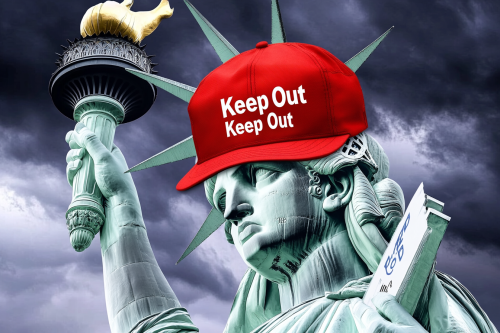A special feature from the Washington Post.
Hundreds of thousands of immigrant workers are trying to stay in the United States. The wait is often long.
The backlog of foreign workers seeking green cards, which allow immigrants to live and work in the United States permanently, numbers more than 330,000. In September, the Department of Labor set up centers in Philadelphia and Dallas to quicken the first step of processing for employment-based green cards.
But while the federal agency said it has spent time and money to ease a complicated traffic jam, immigrants, their employers and lawyers have been growing impatient.
Government officials say the wait has been too long for most of the immigrant workers hoping for their green cards. The oldest case is from August 1998. On March 28, the Labor Department introduced a computerized fast-track processing system to handle new applications. Between the backlog centers and the new sites, labor officials said, they have streamlined a multi-layered process that could have had some waiting as long as six more years. Now, they say, the backlog should be cleared within two years.
In employment-based green card applications, the Labor Department essentially certifies that the employer exists and that the immigrant is being paid the prevailing wage for the job described. In most cases, employers must also prove that they sought to hire U.S. workers for the job but could not. As proof, they provide classified advertisements, competing resumes and summaries of their recruitment methods.
From this stage, known as labor certification, the application travels to the Department of Homeland Security, which conducts its own review and decides whether to allow the immigrant to petition for residency status.
Before the backlog accumulated, immigration attorneys say, labor certification generally took 30 to 90 days. Under the new fast-track system, labor officials say, the process should routinely take up to 60 days.
But there is no such expectation for the 174,000 people awaiting processing. Besides 10 federal workers, the remaining staff of 100 work for Exceed Corp., the company that successfully bid for the backlog contract.
Starting last year, all 50 states sent boxes upon boxes to one of the two backlog sites. Officials said that they hope to act on the applications on a first-in, first-out basis and that they have entered about 80 percent of the applicants' data into a computerized system over the past year.
"In government terms, that has been quite a short amount of time," said Emily Stover DeRocco, assistant secretary of labor for employment and training.
The backlog stems from the passage of legislation that allowed undocumented immigrants or immigrants who had overstayed their visas to apply for green cards if a family member or employer sponsored them -- but they had to do it by April 2001. The result was a surge of green card applications.
The result has also been some resentment of workers who have not been in the United States legally from workers who have.
"They've given priority to illegal immigrants," said Poudyal, who is on the visa for highly skilled but temporary workers known as an H-1B."That's how we've become stuck."
Most difficult, the immigrants and their advocates say, has been the lack of communication from the Department of Labor about their status. Is their folder in a box that has even been opened? Is it in the data-entry process? Is their employer's address being verified, their pay being analyzed?
Companies have started speaking out about U.S. immigration policy, saying it affects their ability to hire the best people. Microsoft Corp. Chairman Bill Gates has repeatedly advocated removing caps on H-1B visas.
Immigration lawyer Liz Espin Stern of Baker & McKenzie LLP said, other countries are trying to make immigrating easier. "Canada, the U.K., Australia are passing foreign-employee-friendly policies," she said. "It's a very inviting program. Our program in the U.S. has shifted. It sends a message: Don't come."
Employers say the backlog also has become expensive. After six years, companies with employees who have been on an H-1B visa must apply for extensions -- and pay the associated legal and filing fees -- every year while the green card is being processed.
"There's a bit of an expense associated with it," said Cliff Sink, the chief executive of EastBanc Technologies LLC in the District. He said the cost of sponsoring one immigrant employee ranges from $3,000 to $5,000. "We stopped paying for the green card because the prices had gone up so much."
His reality might seem incongruous with an immigration policy that mandates that these green cards are employer-driven, but many immigrants do end up paying for their passage to permanent residency.
After paying nearly $10,000 for lawyers, Gopal Ratnam, a journalist from India, said he thinks he has made too hefty an investment to turn back. Besides, his daughters are accustomed to U.S. schools and ways.
"One stage of it has taken four years," said Ratnam, a staff writer for Army Times Publishing Co.'s Defense News in Springfield. "I've invested all the money, resources and time. Should I just say, 'All right, I will give it up and go back to where I came from?' "
Even after the backlog on the Labor Department's end is cleared, immigration attorney Michael Maggio warns, the wait might not be over. He worries the Homeland Security Department might not be able to meet the demand for employment-based green cards with current quotas.
"We're looking at a situation that's just ongoing," he said.
. "You don't know what's inside."
His employer and lawyer have tried to check on the status with no luck. "So you just hope," Poudyal said.
At the center, officials say it is not uncommon for irate immigrants to show up at their doors. They say calls from members of Congress and human resources managers inquiring about specific applications are getting more common. But they remind critics that the system of immigration is driven by employers' needs and not immigrants' wants.
It is not a perfect system, DeRocco said in a recent interview. She said her agency has responded to "tens of thousands" of requests for status reports. Behind every case number, every file, she said, is someone who desperately wants to call the United States home.
"We care very deeply about that," she said. "We not only understand but believe we are doing it for those individuals."
The Labor Department will be involved in discussions about overall immigration reform, she said.
"H visas are not meeting the employers' need," DeRocco said, referring to the temporary work-related visas. "Immigration reform is very high on everyone's agenda."




